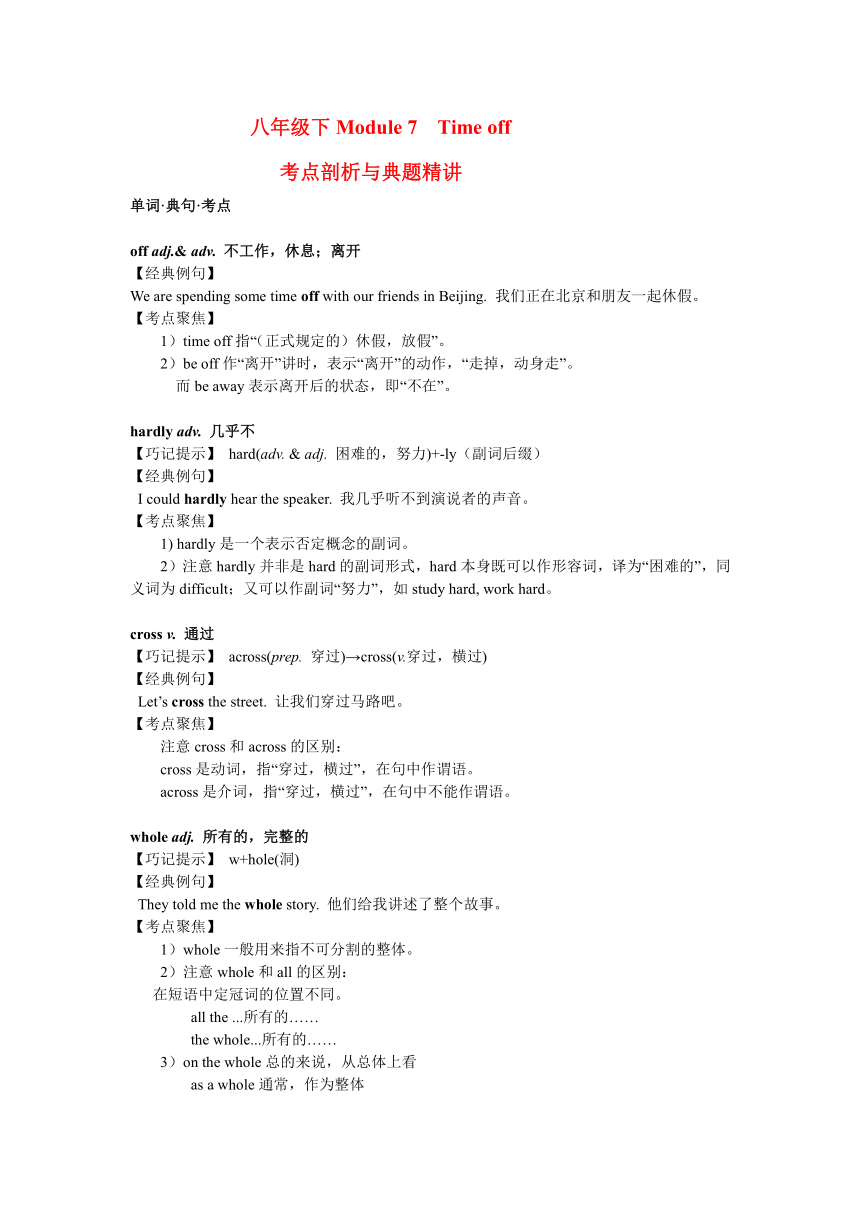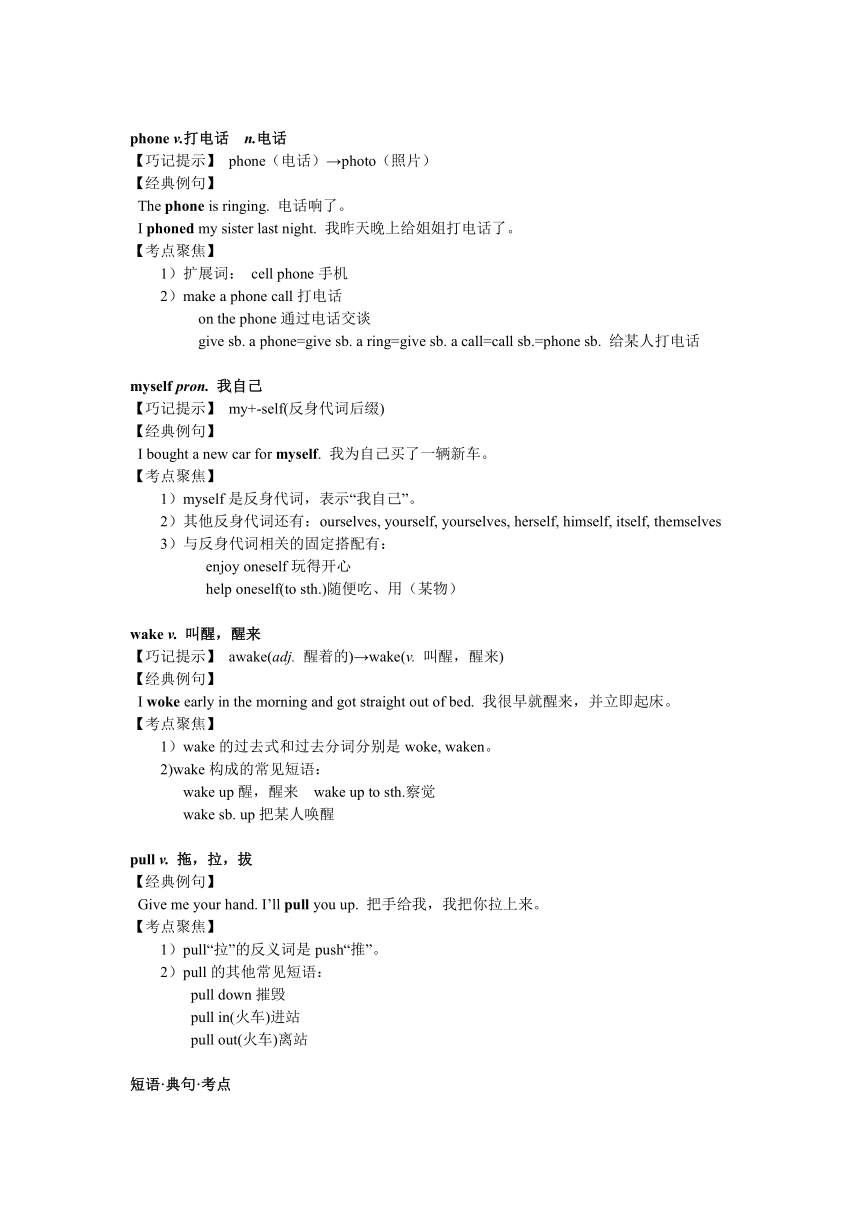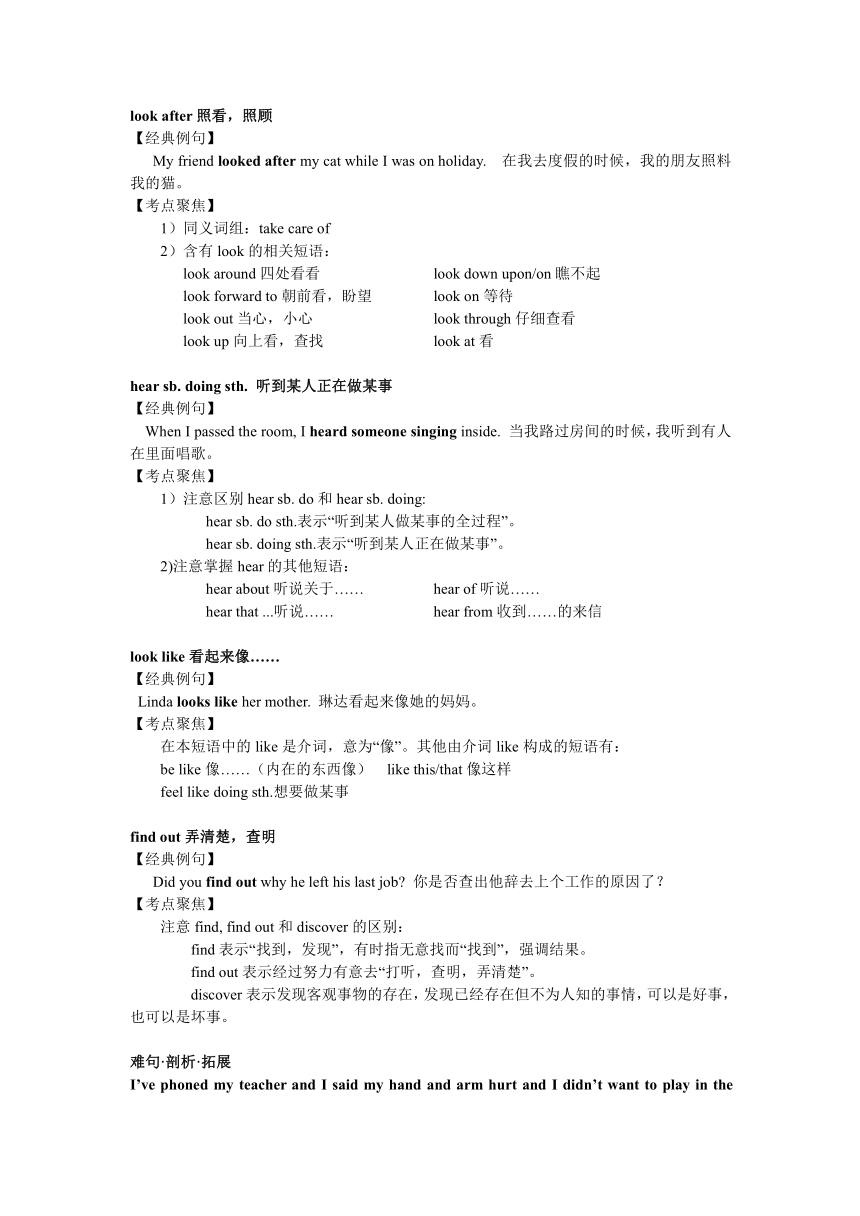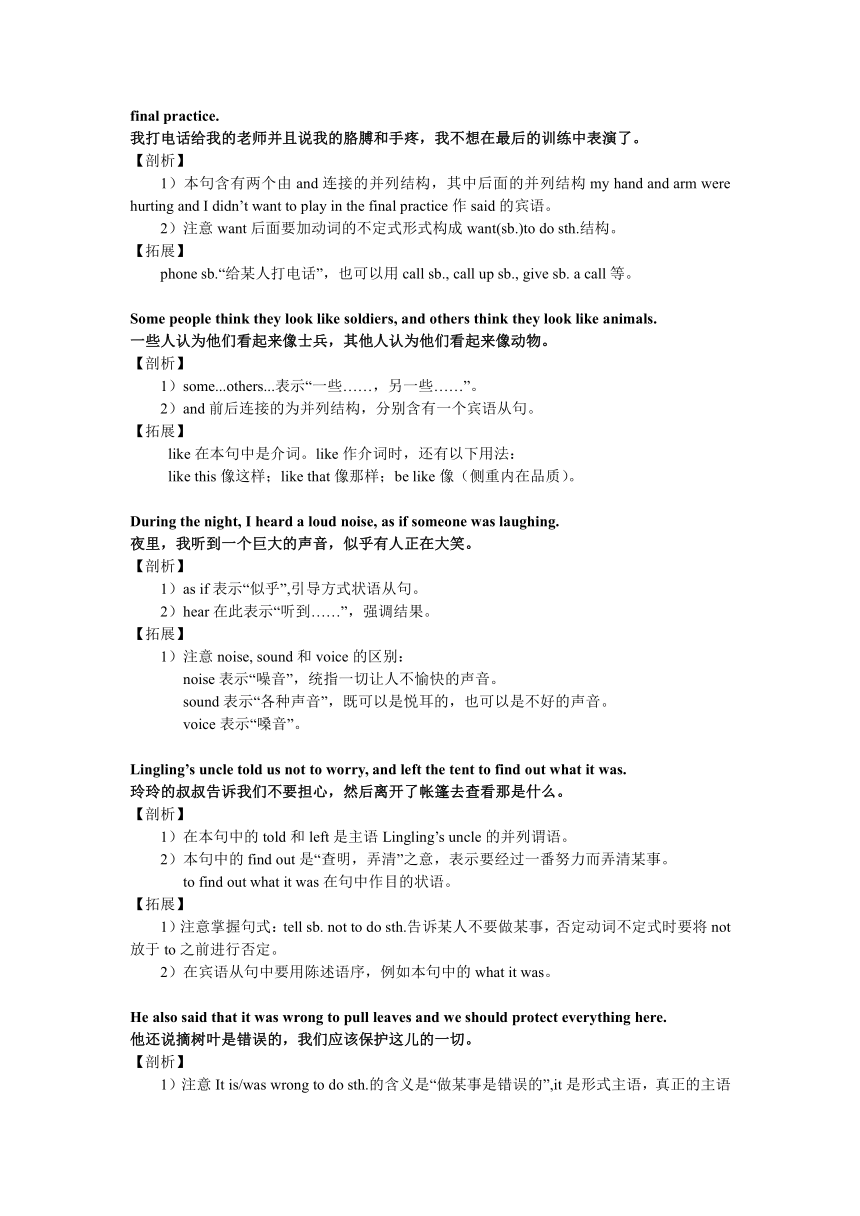八年级下Module 7 Time off考点剖析与典题精讲
文档属性
| 名称 | 八年级下Module 7 Time off考点剖析与典题精讲 |  | |
| 格式 | zip | ||
| 文件大小 | 21.8KB | ||
| 资源类型 | 教案 | ||
| 版本资源 | 外研版 | ||
| 科目 | 英语 | ||
| 更新时间 | 2011-05-10 11:47:42 | ||
图片预览




文档简介
八年级下Module 7 Time off
考点剖析与典题精讲
单词·典句·考点
off adj.& adv. 不工作,休息;离开
【经典例句】
We are spending some time off with our friends in Beijing. 我们正在北京和朋友一起休假。
【考点聚焦】
1)time off指“(正式规定的)休假,放假”。
2)be off作“离开”讲时,表示“离开”的动作,“走掉,动身走”。
而be away表示离开后的状态,即“不在”。
hardly adv. 几乎不
【巧记提示】 hard(adv. & adj. 困难的,努力)+-ly(副词后缀)
【经典例句】
I could hardly hear the speaker. 我几乎听不到演说者的声音。
【考点聚焦】
1) hardly是一个表示否定概念的副词。
2)注意hardly并非是hard的副词形式,hard本身既可以作形容词,译为“困难的”,同义词为difficult;又可以作副词“努力”,如study hard, work hard。
cross v. 通过
【巧记提示】 across(prep. 穿过)→cross(v.穿过,横过)
【经典例句】
Let’s cross the street. 让我们穿过马路吧。
【考点聚焦】
注意cross和across的区别:
cross是动词,指“穿过,横过”,在句中作谓语。
across是介词,指“穿过,横过”,在句中不能作谓语。
whole adj. 所有的,完整的
【巧记提示】 w+hole(洞)
【经典例句】
They told me the whole story. 他们给我讲述了整个故事。
【考点聚焦】
1)whole一般用来指不可分割的整体。
2)注意whole和all的区别:
在短语中定冠词的位置不同。
all the ...所有的……
the whole...所有的……
3)on the whole总的来说,从总体上看
as a whole通常,作为整体
phone v.打电话 n.电话
【巧记提示】 phone(电话)→photo(照片)
【经典例句】
The phone is ringing. 电话响了。
I phoned my sister last night. 我昨天晚上给姐姐打电话了。
【考点聚焦】
1)扩展词: cell phone手机
2)make a phone call打电话
on the phone通过电话交谈
give sb. a phone=give sb. a ring=give sb. a call=call sb.=phone sb. 给某人打电话
myself pron. 我自己
【巧记提示】 my+-self(反身代词后缀)
【经典例句】
I bought a new car for myself. 我为自己买了一辆新车。
【考点聚焦】
1)myself是反身代词,表示“我自己”。
2)其他反身代词还有:ourselves, yourself, yourselves, herself, himself, itself, themselves
3)与反身代词相关的固定搭配有:
enjoy oneself玩得开心
help oneself(to sth.)随便吃、用(某物)
wake v. 叫醒,醒来
【巧记提示】 awake(adj. 醒着的)→wake(v. 叫醒,醒来)
【经典例句】
I woke early in the morning and got straight out of bed. 我很早就醒来,并立即起床。
【考点聚焦】
1)wake的过去式和过去分词分别是woke, waken。
2)wake构成的常见短语:
wake up醒,醒来 wake up to sth.察觉
wake sb. up把某人唤醒
pull v. 拖,拉,拔
【经典例句】
Give me your hand. I’ll pull you up. 把手给我,我把你拉上来。
【考点聚焦】
1)pull“拉”的反义词是push“推”。
2)pull的其他常见短语:
pull down摧毁
pull in(火车)进站
pull out(火车)离站
短语·典句·考点
look after照看,照顾
【经典例句】
My friend looked after my cat while I was on holiday. 在我去度假的时候,我的朋友照料我的猫。
【考点聚焦】
1)同义词组:take care of
2)含有look的相关短语:
look around四处看看 look down upon/on瞧不起
look forward to朝前看,盼望 look on等待
look out当心,小心 look through仔细查看
look up向上看,查找 look at看
hear sb. doing sth. 听到某人正在做某事
【经典例句】
When I passed the room, I heard someone singing inside. 当我路过房间的时候,我听到有人在里面唱歌。
【考点聚焦】
1)注意区别hear sb. do和hear sb. doing:
hear sb. do sth.表示“听到某人做某事的全过程”。
hear sb. doing sth.表示“听到某人正在做某事”。
2)注意掌握hear的其他短语:
hear about听说关于…… hear of听说……
hear that ...听说…… hear from收到……的来信
look like看起来像……
【经典例句】
Linda looks like her mother. 琳达看起来像她的妈妈。
【考点聚焦】
在本短语中的like是介词,意为“像”。其他由介词like构成的短语有:
be like像……(内在的东西像) like this/that像这样
feel like doing sth.想要做某事
find out弄清楚,查明
【经典例句】
Did you find out why he left his last job 你是否查出他辞去上个工作的原因了?
【考点聚焦】
注意find, find out和discover的区别:
find表示“找到,发现”,有时指无意找而“找到”,强调结果。
find out表示经过努力有意去“打听,查明,弄清楚”。
discover表示发现客观事物的存在,发现已经存在但不为人知的事情,可以是好事,也可以是坏事。
难句·剖析·拓展
I’ve phoned my teacher and I said my hand and arm hurt and I didn’t want to play in the final practice.
我打电话给我的老师并且说我的胳膊和手疼,我不想在最后的训练中表演了。
【剖析】
1)本句含有两个由and连接的并列结构,其中后面的并列结构my hand and arm were hurting and I didn’t want to play in the final practice作said的宾语。
2)注意want后面要加动词的不定式形式构成want(sb.)to do sth.结构。
【拓展】
phone sb.“给某人打电话”,也可以用call sb., call up sb., give sb. a call等。
Some people think they look like soldiers, and others think they look like animals.
一些人认为他们看起来像士兵,其他人认为他们看起来像动物。
【剖析】
1)some...others...表示“一些……,另一些……”。
2)and前后连接的为并列结构,分别含有一个宾语从句。
【拓展】
like在本句中是介词。like作介词时,还有以下用法:
like this像这样;like that像那样;be like像(侧重内在品质)。
During the night, I heard a loud noise, as if someone was laughing.
夜里,我听到一个巨大的声音,似乎有人正在大笑。
【剖析】
1)as if表示“似乎”,引导方式状语从句。
2)hear在此表示“听到……”,强调结果。
【拓展】
1)注意noise, sound和voice的区别:
noise表示“噪音”,统指一切让人不愉快的声音。
sound表示“各种声音”,既可以是悦耳的,也可以是不好的声音。
voice表示“嗓音”。
Lingling’s uncle told us not to worry, and left the tent to find out what it was.
玲玲的叔叔告诉我们不要担心,然后离开了帐篷去查看那是什么。
【剖析】
1)在本句中的told和left是主语Lingling’s uncle的并列谓语。
2)本句中的find out是“查明,弄清”之意,表示要经过一番努力而弄清某事。
to find out what it was在句中作目的状语。
【拓展】
1)注意掌握句式:tell sb. not to do sth.告诉某人不要做某事,否定动词不定式时要将not放于to之前进行否定。
2)在宾语从句中要用陈述语序,例如本句中的what it was。
He also said that it was wrong to pull leaves and we should protect everything here.
他还说摘树叶是错误的,我们应该保护这儿的一切。
【剖析】
1)注意It is/was wrong to do sth.的含义是“做某事是错误的”,it是形式主语,真正的主语是后面的不定式结构。
2)should后面接动词原形,在本句中表示要求的语气。
【拓展】
should除了可以表示“要求”之外,同样也可以用来表示“建议”等语气。
语法·剖析·活用
使用宾语从句要注意的问题
1.宾语从句引导词that的省略
在非正式场合下,that引导宾语从句时可以省略。如:
I think(that)you are right.
2.宾语从句的时态呼应
如果主句的谓语是过去时,宾语从句的时态要按照时态呼应规则进行相应的调整。但是若宾语从句表示的是客观真理或自然观念,其谓语时态仍用一般现在时。如:
He said that he had left his umbrella in the library.
The teacher told the students that the Pacific Ocean is the largest ocean in the world.
3.宾语从句否定意义的转移
在think, believe, suppose, expect 等动词所跟的宾语中,如果主句是第一人称且从句谓语是否定的,一般要将否定词not转移至主句谓语上去,而将宾语从句变为肯定形式。如:
I don’t think he has time to play chess with you.
I don’t suppose it is the rush hour yet.
4.whether 与 if
引导介词的宾语从句时,只能用 whether,不用if;与or not连用时,一般用whether,不用if;在句首时常用whether。如:
I am interested in whether he’ll go abroad.
We don’t know whether he will come or not.
5.宾语从句的语序
宾语从句要用陈述语序。如:
I don’t know what your name is.
6.直接引语变为间接引语
间接引语的使用应注意选择合适的动词,通常陈述句用say, tell等词,疑问句用ask, wonder等词,祈使句用tell, order等词,建议用advise, suggest等词。注意这些动词后面的结构和语气。如:
“Could you get some tea for me?” Mr. Blake said to his wife.
→Mr. Blake asked his wife whether she could get some tea for him.
【活学活用】 单项填空
1) Can you make sure ________ the gold ring
A. where Alice had put B. where had Alice put
C. where Alice has put D. where has Alice put
答案:C 从语序上排除B、D两项,从时态上排除A项。
2) —I believe we’ve met somewhere before.
—No,________.
A. it isn’t the same B. it can’t be true
C.I don’t think so D. I’d rather not
答案:C I don’t think so.意为“我不这样认为”,相当于I don’t think we have met somewhere before.
3) The teacher asked me ________ I needed any help.
A. whether B. that
C. what D. which
答案:A 从前面的asked 判断,排除that,句意为“老师问我是否需要帮助”。
4) — The problem is too difficult, can you show me ________
— Sure.
A. what to work it out B. what to work out it
C. how to work it out D. how to work out it
答案:C 如果宾语为代词的话,代词要放在work out中间,因此排除B、D两项。work out 已经接有宾语it,所以用how 引导表示方式。
5) He told us that the earth ________ round the sun.
A. turns B. turned
C. to turn D. turning
答案:A 因为宾语从句表述的是客观真理,所以用一般现在时。
经典例题
书面表达
(2010江苏苏州中考)
某英语杂志社“中学生专栏”举办英语征文比赛,请你根据下表所列的内容要点,用英语以“Learn to Smile”为题写一篇短文,参加比赛。
学会对自己微笑 1.生活中会有不愉快的事,如考试不及格(请再举一个例子);2.使你自信;3.击败你的人有时是你自己。
学会对他人微笑 使人与人更亲近
微笑是一种语言 人人都能懂
注意:
1.词数90左右。短文的开头已为你写好,不计入总词数;
2.参考词汇:自信—confidence(n.),confident(adj.); 打败—beat(beat, beaten)(v.)
3.短文须包括所有内容要点,不要逐句翻译,可适当发挥,使短文连贯、通顺;文中不得出现真实的人名、校名等相关信息。
Learn to Smile
Smile is an attitude(态度)to life.
__________________________________________________________________________________________________________________________________________________________________________________________________________________________________________________________________________________________________________________________________________________________________________________________________________________________________________________________________________________________________________________________________________________________________________________________________________________________________________________________________________________________________________________________________
参考答案:
Learn to Smile
Smile is an attitude to life.
In our life, there may be something unpleasant. For example, you fail in an exam; or another time, you are misunderstood by your friends. These unpleasant things may make you feel bad. Then what will you do Why not learn to smile Smiling to yourself can bring back your confidence. Sometimes, the greatest enemy is yourself; that’s to say, sometimes, you are beaten by yourself. We should also learn to smile to others. It will help us to get closer to others. So, smile is the most widely understood language.
思路解析:
在动笔之前首先要构思全文,想好如何把所给信息最有效的连接起来。应尽量运用已经学过的并列句和从句,避免单一结构。
黑色陷阱:
开头已经给出,陷阱一是所写内容和第一句话完全脱节。陷阱二是规定了字数,所以不要写太多,写太多反而容易犯字、词、语法等方面的错误,而因此失分。
绿色通道:
内容提示作文,注意尽量把提示的内容写全,把所给的单词用上,这些都会成为得分点。如果原文没给标题,要把标题写上,注意标题大小写的书写规范性。
原创题
阅读短文,判断正(T)误(F)。
Dictionaries are very useful books. People use dictionaries to find out the meanings of words. When you are learning English, you would use an English dictionary. Some students have dictionaries. Their dictionaries contain(包含)Chinese and English words. They are useful, and it is usually better to use a dictionary written completely in English. This will help you to begin to think in English. A good English dictionary will show you the correct spelling of a word and its pronunciation(发音).Many dictionaries also show why a word is used in sentences.
1.Dictionaries are used to find the meanings of words.
2.When we write something, we needn’t look up words in a dictionary.
3.A good dictionary will show us how to write a composition.
4.Some dictionaries contain Chinese and English.
5.It is useful for us to use an English dictionary when we learn English.
参考答案:1.T 2.F 3.F 4.T 5.T
思路解析:
第1题题目给的是被动语态,而原文中的句子是主动结构,含义相同。第3题,从全文和常识判断,字典不能教我们写作,它主要是告诉我们单词的拼写、发音及其讲解。
黑色陷阱:
注意第1题和第5题都是文中句子的一种变形,但含义是相同的。判断的时候要把句子结构的转化考虑进去。
绿色通道:
做题时,首先找到本题所讲内容在原文中的位置,先直观判断,是否一致,再仔细推敲,注意细节的变化。
巧学法园地
直接引语变间接引语口诀
1.当直接引语为陈述句,变成间接引语的“顺口溜”是:
去掉引号加that,人称变化要灵活,
时态向后退一步,状语变化按规则。
2.当直接引语为一般疑问句,变成间接引语的“顺口溜”是:
去掉引号加if,陈述语序要记住,
时态人称和状语,小心变化别马虎。
3.当直接引语是特殊疑问句,变成间接引语的“顺口溜”是:
直接去引号,陈述莫忘掉,
小心助动词,丢它最重要。
4.当直接引语是祈使句,变成间接引语的“顺口溜”是:
去掉引号要加to, ask,tell须记住,
直引若是否定式,not加在to前部。
5.对于人称变化,要求学生们记住的“顺口溜”是:
第一人称看主语,第二人称看宾语,
宾语若是不存在,活用代词I, my, me。
考点剖析与典题精讲
单词·典句·考点
off adj.& adv. 不工作,休息;离开
【经典例句】
We are spending some time off with our friends in Beijing. 我们正在北京和朋友一起休假。
【考点聚焦】
1)time off指“(正式规定的)休假,放假”。
2)be off作“离开”讲时,表示“离开”的动作,“走掉,动身走”。
而be away表示离开后的状态,即“不在”。
hardly adv. 几乎不
【巧记提示】 hard(adv. & adj. 困难的,努力)+-ly(副词后缀)
【经典例句】
I could hardly hear the speaker. 我几乎听不到演说者的声音。
【考点聚焦】
1) hardly是一个表示否定概念的副词。
2)注意hardly并非是hard的副词形式,hard本身既可以作形容词,译为“困难的”,同义词为difficult;又可以作副词“努力”,如study hard, work hard。
cross v. 通过
【巧记提示】 across(prep. 穿过)→cross(v.穿过,横过)
【经典例句】
Let’s cross the street. 让我们穿过马路吧。
【考点聚焦】
注意cross和across的区别:
cross是动词,指“穿过,横过”,在句中作谓语。
across是介词,指“穿过,横过”,在句中不能作谓语。
whole adj. 所有的,完整的
【巧记提示】 w+hole(洞)
【经典例句】
They told me the whole story. 他们给我讲述了整个故事。
【考点聚焦】
1)whole一般用来指不可分割的整体。
2)注意whole和all的区别:
在短语中定冠词的位置不同。
all the ...所有的……
the whole...所有的……
3)on the whole总的来说,从总体上看
as a whole通常,作为整体
phone v.打电话 n.电话
【巧记提示】 phone(电话)→photo(照片)
【经典例句】
The phone is ringing. 电话响了。
I phoned my sister last night. 我昨天晚上给姐姐打电话了。
【考点聚焦】
1)扩展词: cell phone手机
2)make a phone call打电话
on the phone通过电话交谈
give sb. a phone=give sb. a ring=give sb. a call=call sb.=phone sb. 给某人打电话
myself pron. 我自己
【巧记提示】 my+-self(反身代词后缀)
【经典例句】
I bought a new car for myself. 我为自己买了一辆新车。
【考点聚焦】
1)myself是反身代词,表示“我自己”。
2)其他反身代词还有:ourselves, yourself, yourselves, herself, himself, itself, themselves
3)与反身代词相关的固定搭配有:
enjoy oneself玩得开心
help oneself(to sth.)随便吃、用(某物)
wake v. 叫醒,醒来
【巧记提示】 awake(adj. 醒着的)→wake(v. 叫醒,醒来)
【经典例句】
I woke early in the morning and got straight out of bed. 我很早就醒来,并立即起床。
【考点聚焦】
1)wake的过去式和过去分词分别是woke, waken。
2)wake构成的常见短语:
wake up醒,醒来 wake up to sth.察觉
wake sb. up把某人唤醒
pull v. 拖,拉,拔
【经典例句】
Give me your hand. I’ll pull you up. 把手给我,我把你拉上来。
【考点聚焦】
1)pull“拉”的反义词是push“推”。
2)pull的其他常见短语:
pull down摧毁
pull in(火车)进站
pull out(火车)离站
短语·典句·考点
look after照看,照顾
【经典例句】
My friend looked after my cat while I was on holiday. 在我去度假的时候,我的朋友照料我的猫。
【考点聚焦】
1)同义词组:take care of
2)含有look的相关短语:
look around四处看看 look down upon/on瞧不起
look forward to朝前看,盼望 look on等待
look out当心,小心 look through仔细查看
look up向上看,查找 look at看
hear sb. doing sth. 听到某人正在做某事
【经典例句】
When I passed the room, I heard someone singing inside. 当我路过房间的时候,我听到有人在里面唱歌。
【考点聚焦】
1)注意区别hear sb. do和hear sb. doing:
hear sb. do sth.表示“听到某人做某事的全过程”。
hear sb. doing sth.表示“听到某人正在做某事”。
2)注意掌握hear的其他短语:
hear about听说关于…… hear of听说……
hear that ...听说…… hear from收到……的来信
look like看起来像……
【经典例句】
Linda looks like her mother. 琳达看起来像她的妈妈。
【考点聚焦】
在本短语中的like是介词,意为“像”。其他由介词like构成的短语有:
be like像……(内在的东西像) like this/that像这样
feel like doing sth.想要做某事
find out弄清楚,查明
【经典例句】
Did you find out why he left his last job 你是否查出他辞去上个工作的原因了?
【考点聚焦】
注意find, find out和discover的区别:
find表示“找到,发现”,有时指无意找而“找到”,强调结果。
find out表示经过努力有意去“打听,查明,弄清楚”。
discover表示发现客观事物的存在,发现已经存在但不为人知的事情,可以是好事,也可以是坏事。
难句·剖析·拓展
I’ve phoned my teacher and I said my hand and arm hurt and I didn’t want to play in the final practice.
我打电话给我的老师并且说我的胳膊和手疼,我不想在最后的训练中表演了。
【剖析】
1)本句含有两个由and连接的并列结构,其中后面的并列结构my hand and arm were hurting and I didn’t want to play in the final practice作said的宾语。
2)注意want后面要加动词的不定式形式构成want(sb.)to do sth.结构。
【拓展】
phone sb.“给某人打电话”,也可以用call sb., call up sb., give sb. a call等。
Some people think they look like soldiers, and others think they look like animals.
一些人认为他们看起来像士兵,其他人认为他们看起来像动物。
【剖析】
1)some...others...表示“一些……,另一些……”。
2)and前后连接的为并列结构,分别含有一个宾语从句。
【拓展】
like在本句中是介词。like作介词时,还有以下用法:
like this像这样;like that像那样;be like像(侧重内在品质)。
During the night, I heard a loud noise, as if someone was laughing.
夜里,我听到一个巨大的声音,似乎有人正在大笑。
【剖析】
1)as if表示“似乎”,引导方式状语从句。
2)hear在此表示“听到……”,强调结果。
【拓展】
1)注意noise, sound和voice的区别:
noise表示“噪音”,统指一切让人不愉快的声音。
sound表示“各种声音”,既可以是悦耳的,也可以是不好的声音。
voice表示“嗓音”。
Lingling’s uncle told us not to worry, and left the tent to find out what it was.
玲玲的叔叔告诉我们不要担心,然后离开了帐篷去查看那是什么。
【剖析】
1)在本句中的told和left是主语Lingling’s uncle的并列谓语。
2)本句中的find out是“查明,弄清”之意,表示要经过一番努力而弄清某事。
to find out what it was在句中作目的状语。
【拓展】
1)注意掌握句式:tell sb. not to do sth.告诉某人不要做某事,否定动词不定式时要将not放于to之前进行否定。
2)在宾语从句中要用陈述语序,例如本句中的what it was。
He also said that it was wrong to pull leaves and we should protect everything here.
他还说摘树叶是错误的,我们应该保护这儿的一切。
【剖析】
1)注意It is/was wrong to do sth.的含义是“做某事是错误的”,it是形式主语,真正的主语是后面的不定式结构。
2)should后面接动词原形,在本句中表示要求的语气。
【拓展】
should除了可以表示“要求”之外,同样也可以用来表示“建议”等语气。
语法·剖析·活用
使用宾语从句要注意的问题
1.宾语从句引导词that的省略
在非正式场合下,that引导宾语从句时可以省略。如:
I think(that)you are right.
2.宾语从句的时态呼应
如果主句的谓语是过去时,宾语从句的时态要按照时态呼应规则进行相应的调整。但是若宾语从句表示的是客观真理或自然观念,其谓语时态仍用一般现在时。如:
He said that he had left his umbrella in the library.
The teacher told the students that the Pacific Ocean is the largest ocean in the world.
3.宾语从句否定意义的转移
在think, believe, suppose, expect 等动词所跟的宾语中,如果主句是第一人称且从句谓语是否定的,一般要将否定词not转移至主句谓语上去,而将宾语从句变为肯定形式。如:
I don’t think he has time to play chess with you.
I don’t suppose it is the rush hour yet.
4.whether 与 if
引导介词的宾语从句时,只能用 whether,不用if;与or not连用时,一般用whether,不用if;在句首时常用whether。如:
I am interested in whether he’ll go abroad.
We don’t know whether he will come or not.
5.宾语从句的语序
宾语从句要用陈述语序。如:
I don’t know what your name is.
6.直接引语变为间接引语
间接引语的使用应注意选择合适的动词,通常陈述句用say, tell等词,疑问句用ask, wonder等词,祈使句用tell, order等词,建议用advise, suggest等词。注意这些动词后面的结构和语气。如:
“Could you get some tea for me?” Mr. Blake said to his wife.
→Mr. Blake asked his wife whether she could get some tea for him.
【活学活用】 单项填空
1) Can you make sure ________ the gold ring
A. where Alice had put B. where had Alice put
C. where Alice has put D. where has Alice put
答案:C 从语序上排除B、D两项,从时态上排除A项。
2) —I believe we’ve met somewhere before.
—No,________.
A. it isn’t the same B. it can’t be true
C.I don’t think so D. I’d rather not
答案:C I don’t think so.意为“我不这样认为”,相当于I don’t think we have met somewhere before.
3) The teacher asked me ________ I needed any help.
A. whether B. that
C. what D. which
答案:A 从前面的asked 判断,排除that,句意为“老师问我是否需要帮助”。
4) — The problem is too difficult, can you show me ________
— Sure.
A. what to work it out B. what to work out it
C. how to work it out D. how to work out it
答案:C 如果宾语为代词的话,代词要放在work out中间,因此排除B、D两项。work out 已经接有宾语it,所以用how 引导表示方式。
5) He told us that the earth ________ round the sun.
A. turns B. turned
C. to turn D. turning
答案:A 因为宾语从句表述的是客观真理,所以用一般现在时。
经典例题
书面表达
(2010江苏苏州中考)
某英语杂志社“中学生专栏”举办英语征文比赛,请你根据下表所列的内容要点,用英语以“Learn to Smile”为题写一篇短文,参加比赛。
学会对自己微笑 1.生活中会有不愉快的事,如考试不及格(请再举一个例子);2.使你自信;3.击败你的人有时是你自己。
学会对他人微笑 使人与人更亲近
微笑是一种语言 人人都能懂
注意:
1.词数90左右。短文的开头已为你写好,不计入总词数;
2.参考词汇:自信—confidence(n.),confident(adj.); 打败—beat(beat, beaten)(v.)
3.短文须包括所有内容要点,不要逐句翻译,可适当发挥,使短文连贯、通顺;文中不得出现真实的人名、校名等相关信息。
Learn to Smile
Smile is an attitude(态度)to life.
__________________________________________________________________________________________________________________________________________________________________________________________________________________________________________________________________________________________________________________________________________________________________________________________________________________________________________________________________________________________________________________________________________________________________________________________________________________________________________________________________________________________________________________________________
参考答案:
Learn to Smile
Smile is an attitude to life.
In our life, there may be something unpleasant. For example, you fail in an exam; or another time, you are misunderstood by your friends. These unpleasant things may make you feel bad. Then what will you do Why not learn to smile Smiling to yourself can bring back your confidence. Sometimes, the greatest enemy is yourself; that’s to say, sometimes, you are beaten by yourself. We should also learn to smile to others. It will help us to get closer to others. So, smile is the most widely understood language.
思路解析:
在动笔之前首先要构思全文,想好如何把所给信息最有效的连接起来。应尽量运用已经学过的并列句和从句,避免单一结构。
黑色陷阱:
开头已经给出,陷阱一是所写内容和第一句话完全脱节。陷阱二是规定了字数,所以不要写太多,写太多反而容易犯字、词、语法等方面的错误,而因此失分。
绿色通道:
内容提示作文,注意尽量把提示的内容写全,把所给的单词用上,这些都会成为得分点。如果原文没给标题,要把标题写上,注意标题大小写的书写规范性。
原创题
阅读短文,判断正(T)误(F)。
Dictionaries are very useful books. People use dictionaries to find out the meanings of words. When you are learning English, you would use an English dictionary. Some students have dictionaries. Their dictionaries contain(包含)Chinese and English words. They are useful, and it is usually better to use a dictionary written completely in English. This will help you to begin to think in English. A good English dictionary will show you the correct spelling of a word and its pronunciation(发音).Many dictionaries also show why a word is used in sentences.
1.Dictionaries are used to find the meanings of words.
2.When we write something, we needn’t look up words in a dictionary.
3.A good dictionary will show us how to write a composition.
4.Some dictionaries contain Chinese and English.
5.It is useful for us to use an English dictionary when we learn English.
参考答案:1.T 2.F 3.F 4.T 5.T
思路解析:
第1题题目给的是被动语态,而原文中的句子是主动结构,含义相同。第3题,从全文和常识判断,字典不能教我们写作,它主要是告诉我们单词的拼写、发音及其讲解。
黑色陷阱:
注意第1题和第5题都是文中句子的一种变形,但含义是相同的。判断的时候要把句子结构的转化考虑进去。
绿色通道:
做题时,首先找到本题所讲内容在原文中的位置,先直观判断,是否一致,再仔细推敲,注意细节的变化。
巧学法园地
直接引语变间接引语口诀
1.当直接引语为陈述句,变成间接引语的“顺口溜”是:
去掉引号加that,人称变化要灵活,
时态向后退一步,状语变化按规则。
2.当直接引语为一般疑问句,变成间接引语的“顺口溜”是:
去掉引号加if,陈述语序要记住,
时态人称和状语,小心变化别马虎。
3.当直接引语是特殊疑问句,变成间接引语的“顺口溜”是:
直接去引号,陈述莫忘掉,
小心助动词,丢它最重要。
4.当直接引语是祈使句,变成间接引语的“顺口溜”是:
去掉引号要加to, ask,tell须记住,
直引若是否定式,not加在to前部。
5.对于人称变化,要求学生们记住的“顺口溜”是:
第一人称看主语,第二人称看宾语,
宾语若是不存在,活用代词I, my, me。
同课章节目录
- Module 1 Feelings and impressions
- Unit 1 It smells delicious.
- Unit 2 I feel nervous when I speak Chinese .
- Unit 3 Language in use
- Module 2 Experiences
- Unit 1 I've also entered lots of speaking competi
- Unit 2 They have seen the Pyramids.
- Unit 3 Language in use
- Module 3 Journey to space
- Unit 1 Has it arrived yet?
- Unit 2 We have not found life on any other planet
- Unit 3 Language in use
- Module 4 Seeing the docto
- Unit 1 I haven't done much exercise since I got m
- Unit 2 We have played football for a year now
- Unit 3 Language in use
- Module 5 Cartoons
- Unit 1 It's time to watch a cartoon.
- Unit 2 Tintin has been popular for over eighty yea
- Unit 3 Language in use
- Revision module A
- Module 6 Hobbies
- Unit 1 Do you collect anything ?
- Unit 2 Hobbies can make you grow as a person.
- Unit 3 Language in use
- Module 7 Summer in Los Angeles
- Unit 1 Please write to me and send me some photos
- Unit 2 Fill out a form and come to learn English
- Unit 3 Language in use
- Module 8 Time off
- Unit 1 I can hardly believe we are in the city ce
- Unit 2 We thought somebody was moving about
- Unit 3 Language in use
- Module 9 Friendship
- Unit 1 Could I ask if you've mentioned this to he
- Unit 2 I believe that the world is what you think
- Unit 3 Language in use
- Module 10 On the radio
- Unit 1 I hope that you can join us one day
- Unit 2 It seemed that they were speaking to me in
- Unit 3 Language in use
- Revision module B
